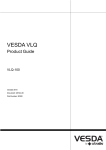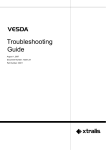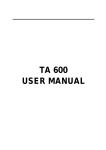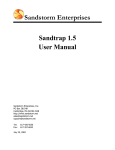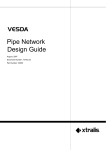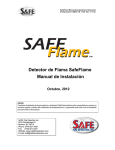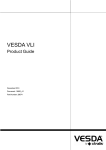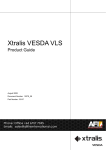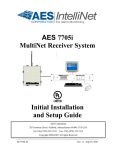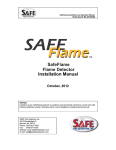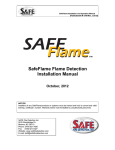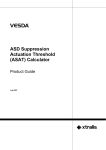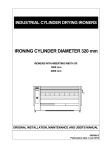Download VLQ-100 Product Manual
Transcript
VESDA VLQ Product Guide VLQ-100 February 2014 Document: 26104_03 Part Number: 30320 VESDA by Xtralis VESDA VLQ Product Guide Intellectual Property and Copyright This document includes registered and unregistered trademarks. All trademarks displayed are the trademarks of their respective owners. Your use of this document does not constitute or create a licence or any other right to use the name and/or trademark and/or label. This document is subject to copyright owned by Xtralis AG (“Xtralis”). You agree not to copy, communicate to the public, adapt, distribute, transfer, sell, modify or publish any contents of this document without the express prior written consent of Xtralis. Disclaimer The contents of this document is provided on an “as is” basis. No representation or warranty (either express or implied) is made as to the completeness, accuracy or reliability of the contents of this document. The manufacturer reserves the right to change designs or specifications without obligation and without further notice. Except as otherwise provided, all warranties, express or implied, including without limitation any implied warranties of merchantability and fitness for a particular purpose are expressly excluded. General Warning This product must only be installed, configured and used strictly in accordance with the General Terms and Conditions, User Manual and product documents available from Xtralis. All proper health and safety precautions must be taken during the installation, commissioning and maintenance of the product. The system should not be connected to a power source until all the components have been installed. Proper safety precautions must be taken during tests and maintenance of the products when these are still connected to the power source. Failure to do so or tampering with the electronics inside the products can result in an electric shock causing injury or death and may cause equipment damage. Xtralis is not responsible and cannot be held accountable for any liability that may arise due to improper use of the equipment and/or failure to take proper precautions. Only persons trained through an Xtralis accredited training course can install, test and maintain the system. Liability You agree to install, configure and use the products strictly in accordance with the User Manual and product documents available from Xtralis. Xtralis is not liable to you or any other person for incidental, indirect, or consequential loss, expense or damages of any kind including without limitation, loss of business, loss of profits or loss of data arising out of your use of the products. Without limiting this general disclaimer the following specific warnings and disclaimers also apply: Fitness for Purpose You agree that you have been provided with a reasonable opportunity to appraise the products and have made your own independent assessment of the fitness or suitability of the products for your purpose. You acknowledge that you have not relied on any oral or written information, representation or advice given by or on behalf of Xtralis or its representatives. Total Liability To the fullest extent permitted by law that any limitation or exclusion cannot apply, the total liability of Xtralis in relation to the products is limited to: 1. in the case of services, the cost of having the services supplied again; or 2. in the case of goods, the lowest cost of replacing the goods, acquiring equivalent goods or having the goods repaired. Indemnification You agree to fully indemnify and hold Xtralis harmless for any claim, cost, demand or damage (including legal costs on a full indemnity basis) incurred or which may be incurred arising from your use of the products. Miscellaneous If any provision outlined above is found to be invalid or unenforceable by a court of law, such invalidity or unenforceability will not affect the remainder which will continue in full force and effect. All rights not expressly granted are reserved. www.xtralis.com i VESDA VLQ Product Guide VESDA by Xtralis Scope The VESDA VLQ Product Guide provides a comprehensive description of the VLQ detector. This guide introduces the VESDA VLQ features, technical specifications and gives an understanding of its components and their function. You will also find instructions on installing, cabling and powering up the detector. This guide is for anyone involved with the design, maintenance and purchasing of a VESDA VLQ system. It is assumed that anyone using this product has the knowledge and appropriate certification from local fire and electrical authorities. Document Conventions The following typographic conventions are used in this document: Convention Description Bold Used to denote: emphasis. Used for names of menus, menu options, toolbar buttons Italics Used to denote: references to other parts of this document or other documents. Used for the result of an action. The following icons are used in this document: Convention Description Caution: This icon is used to indicate that there is a danger to equipment. The danger could be loss of data, physical damage, or permanent corruption of configuration details. Warning: This icon is used to indicate that there is a danger of electric shock. This may lead to death or permanent injury. Warning: This icon is used to indicate that there is a danger of inhaling dangerous substances. This may lead to death or permanent injury. Contact Us UK and Europe +44 1442 242 330 D-A-CH +49 431 23284 1 The Americas +1 781 740 2223 Middle East +962 6 588 5622 Asia +86 21 5240 0077 Australia and New Zealand +61 3 9936 7000 www.xtralis.com ii www.xtralis.com VESDA by Xtralis VESDA VLQ Product Guide Codes and Standards Information for Air Sampling Smoke Detection We strongly recommend that this document is read in conjunction with the appropriate local codes and standards for smoke detection and electrical connections. This document contains generic product information and some sections may not comply with all local codes and standards. In these cases, the local codes and standards must take precedence. The information below was correct at time of printing but may now be out of date, check with your local codes, standards and listings for the current restrictions. FCC Compliance Statement This equipment has been tested and found to comply with the limits for a Class B digital device, pursuant to part 15 of the FCC Rules. These limits are designed to provide reasonable protection against harmful interference in a residential installation. This equipment generates, uses and can radiate radio frequency energy and, if not installed and used in accordance with the instruction, may cause harmful interference to radio communications. However, there is no guarantee that interference will not occur in a particular installation. If this equipment does cause harmful interference to radio or television reception, the user is encouraged to try to correct the interference by one or more of the following measures; re-orientate or relocate the receiving antenna, increase the separation between the equipment and receiver, connect the equipment to a power outlet which is on a different power circuit to the receiver or consult the dealer or an experienced radio/television technician for help. FDA This Xtralis product incorporates a laser device and is classified as a Class 1 laser product that complies with FDA regulations 21 CFR 1040.10. The laser is housed in a sealed detector chamber and contains no serviceable parts. The laser emits invisible light and can be hazardous if viewed with the naked eye. Under no circumstances should the detector chamber be opened. The laser chamber is identified by the label shown below: DO NOT OPEN NO SERVICEABLE PARTS DANGER NE PAS OUVRIR DISPOSITIFS/PIECES NON ECHANGEABLES Laser Radiation when Open AVOID DIRECT EXPOSURE TO BEAM Rayonnement Laser en cas d’ouverture EVITEZ TOUTE EXPOSITION DIRECTE AU FAISCEAU Product Listings l l l l UL ULC VNIPPO EN 54-20 and other agencies (pending) Document: 26104_03 Part Number: 30320 www.xtralis.com iii VESDA VLQ Product Guide VESDA by Xtralis This page is intentionally left blank. iv www.xtralis.com VESDA by Xtralis VESDA VLQ Product Guide Table of Contents 1 2 Introduction 3 1.1 Features 4 Product Information 5 2.1 2.2 2.3 2.4 3 4 5 6 7 8 9 How it Works Detector Overview Specifications Dimensions 5 6 9 10 Air Sampling Pipe Network 11 3.1 3.2 3.3 3.4 11 11 11 12 Installation Considerations Pipe Inlets Exhaust Air Air Sampling Configurations Installation 15 4.1 4.2 4.3 4.4 4.5 4.6 16 22 25 26 27 27 Mounting Wiring Specify Backup Battery for Power Supply Installation Checklist Powering Up Preliminary System Check Configuration 29 5.1 5.2 5.3 29 29 30 Logging on using the Display Panel Setting the time using the Display Panel DIP Switch Configuration Commissioning 31 6.1 6.2 31 31 AutoLearn Smoke Commissioning Smoke Test Xtralis QSC Software 33 7.1 7.2 7.3 7.4 33 33 34 35 Installation Functions Configuration Device Information Maintenance 37 8.1 37 Replacing the Filter Troubleshooting 41 9.1 41 Fault Codes www.xtralis.com 1 VESDA VLQ Product Guide VESDA by Xtralis This page is intentionally left blank. 2 www.xtralis.com VESDA by Xtralis 1 VESDA VLQ Product Guide Introduction The VESDA VLQ is an Aspirating Smoke Detector (ASD) that provides very early warning of fire conditions by drawing air samples through sampling holes located in an air sampling pipe network. The VESDA VLQ detector is specifically designed to cater for small areas up to 100 m² (1000 ft²). VESDA VLQ is suited to several applications, including but not limited to: l l l l l l l l l l l l l l l l l Telecommunications land line remote offices Base station controllers (BSC) Base transceiver stations (BTS) Server rooms Datacenter containers IT/equipment cabinets Controlled environmental vaults (CEV) Semi-conductor tools Modular laboratories Anechoic chambers Flight simulators Generator enclosures Signaling huts Pump houses Ammunitions holding areas Hyperbaric chambers Barracks self-contained units Connection to the detector using Xtralis QSC software is available via the USB interface. Figure 1-1: VESDA VLQ The detector contains dry-contact relays which allow connectivity to fire warning and fire suppression release systems, and integration into a building management system (BMS). www.xtralis.com 3 VESDA VLQ Product Guide 1.1 VESDA by Xtralis Features The VESDA VLQ detector provides the following features: l l l l l l l l l l l l l l l l 4 Laser-based absolute smoke detection Clean air barriers for optics protection Up to 100 m² (1000 ft²)coverage Up to 2 x 6m (2 x 20ft) pipes (straight), up to 2 x 9m (2 x 30ft) pipes (branched) 2 or 4 VEWFD / EWFD (NFPA76), or 2 or 4 Class A / Class B (EN 54-20) sample holes Metric/Imperial pipe inlets Pre-alarm, Alarm and Fault Relays 5 LEDs: Pre-alarm, Fire-alarm, Fault, Power, Filter replacement Monitored on-board filter AutoLearn Smoke General Purpose Input (GPI) IP30 enclosure Xtralis QSC software support USB for direct PC connection Event log Low power consumption www.xtralis.com VESDA by Xtralis 2 VESDA VLQ Product Guide Product Information 2.1 How it Works The VESDA VLQ detector continually samples air from the protected environment via two pipe inlets for the sampling pipes on each side of the pipe inlets (A1, A2). Upon entering the detector, the air passes through respective inlet manifolds (B1, B2) and the aspirators (C1, C2). The sampled air then enters the filter (D) where the majority is exhausted out through filter exhaust (I2) and a portion from each inlet is separated into two pathways, one pathway enters as clean air (E1,E2) and the other pathway enters as sampled air (F1,F2) into the detection chamber (G). Sampled air is used for smoke detection and the clean air used for optics protection. After smoke detection the air is exhausted out of the chamber exhaust (I1). Flow measurement is performed at the chamber exhaust (H). Legend A1 A2 B1 B2 C1 C2 A Pipe Inlets B Manifolds C Aspirators D Filter E Clean Air F Sample Air G Detection Chamber H Flow Sensor I Exhaust D E1 F1 E2 F2 G H I2 I1 Figure 2-1: Air Path www.xtralis.com 5 VESDA VLQ Product Guide 2.2 VESDA by Xtralis Detector Overview The VESDA VLQ detector is a lightweight unit designed to be ceiling or wall mounted and operates with a simple sampling pipe network. The detector unit features two sampling pipe inlets, unobtrusive exhaust vents, a simple control panel and display, and a buzzer to provide audio notifications. A USB port, described below in Section 2.2.3, provides the ability to interface with a computer, which allows configuration with the Xtralis QSC software. Configuration DIP switches and wiring terminals are located beneath the detector and are accessible by removing the detector base.. Legend B A A Sampling Pipe Inlets B Exhaust Vents C Front Panel A C Figure 2-2: VESDA VLQ Detector Overview 2.2.1 Front Panel The VESDA VLQ front panel contains a series of indicators and buttons. These are described below. 88 B C A D E Figure 2-3: VESDA VLQ Front Panel and Status LEDs Indicators The VESDA VLQ detector provides information via a series of Status LEDs. Table 2-1: LED Indicators LED 6 Color Description A Power Green The Power LED illuminates when the detector is powered up. B Filter Replacement Yellow The Filter Replacement LED is lit when the filter is due for replacement. C Fault Yellow The Fault LED is lit when a fault condition is detected. D Pre-Alarm Red The Pre-Alarm LED is lit when the Pre-Alarm threshold is reached. E Fire-Alarm Red The Fire LED is lit when the Fire threshold is reached. www.xtralis.com VESDA by Xtralis VESDA VLQ Product Guide Buttons The VESDA VLQ detector provides accessibility to a range of functions via a set of control buttons. Table 2-2: Control Buttons Button Reset / Silence Description Resetting the detector unlatches all latched alarms and faults, returns relays to their normal state and clears the active event list. Silencing silences the buzzer for the current fault. l l l To reset the detector, press this button once, 'rs' is displayed on the panel. To silence the buzzer, press and hold this button till "SI" is displayed on the panel (5 to 10 seconds). SI is displayed alternately with the highest priority fault code. The buzzer will remain silent unless another fault is reported. To take detector out of Silence mode, press this button once while detector is displaying "SI". While the filter is removed, pressing the Reset / Silence button once will reset the filter use percentage value. Disable / Standby Disabling the detector disables all relay outputs with the exception of the fault relay. The aspirator remains active. Standby shuts down the aspirator and puts the detector standby mode. There is no smoke detection during standby, and the fault relay is activated. l l l To disable the detector, press this button once. To re-enable the unit, press the button while "db" is displayed on the panel. To place the detector in standby mode, press and hold this button until "Sb" is displayed on the panel (5 to 10 seconds). To take detector out of standby mode, push and hold this button when "Sb" is displayed on the panel (5 to 10 seconds). Note: Test Two Test modes are available: l l Lamp and Buzzer Test: Press this button to ensure that all LEDs, display segments and buzzer operate correctly. "Lt" is displayed momentarily when the button is pressed. Alarm and Fault Test: Press and hold this button until "At" is displayed on the front panel (5 to 10 seconds). It activates alarm and fault relays. To stop the test press and hold this button when "At" is displayed on the panel. Note: www.xtralis.com You must be logged on to the detector through front panel to use this button. Refer to Section 5.1 for further information. You must be logged on to the detector through front panel to use this button. Refer to Section 5.1 for further information. 7 VESDA VLQ Product Guide VESDA by Xtralis Table 2-2: Control Buttons (continued...) Button Normalize Airflow / AutoLearn Smoke Description Airflow Normalization sets the reference point for airflow thresholds based on ambient operating conditions. AutoLearn Smoke sets the alarm thresholds based on the environmental conditions. l l Press this button once to start the flow normalization, 'no' is displayed on the panel. Normalization takes between 5 to 10 minutes. To cancel normalization press this button while 'no' is displayed. To start the AutoLearn smoke press and hold this button till "AL" is displayed on the panel. AutoLearn takes 15 minutes to complete when started from the panel. To cancel the AutoLearn press and hold this button when "AL" is displayed. Notes: l l l 2.2.2 AutoLearn Smoke thresholds are volatile, therefore if thresholds are set using AutoLearn smoke then it must be run each time the detector is powered up. AutoLearn Smoke over-rides the DIP switch settings within the smoke threshold range. Refer to Section 5.3 for further information. You must be logged on to the detector through the front panel to use this button. Refer to Section 5.1 for further information. Buzzer The buzzer will sound under the following conditions: l l l l l During power up self testing. When a Pre-Alarm is raised, the buzzer will alternate between on and off until the detector is silenced or the smoke is no longer present. When a Fire alarm is raised, the buzzer will beep continuously until the detector is silenced or the smoke is no longer present. When a Fault is detected, the buzzer will alternate between on and off until the detector is silenced or the fault condition is corrected. During a manually initiated system test. 2.2.3 USB Port Detector configuration can be performed using the Xtralis QSC software installed on a computer connected to the detector via the USB port. The USB port is located on the outside of the detector, beneath the shroud. It is necessary to remove the rubber grommet in order to access this port. Figure 2-4: USB Port 8 www.xtralis.com VESDA by Xtralis 2.3 VESDA VLQ Product Guide Specifications Table 2-3: VLQ Detector Specifications Specification Value Supply Voltage 24 VDC nominal (18 to 30 VDC), externally supplied from UL1481 / EN54-4 listed power supply (as appropriate to meet local codes). Ensure that the power supply is installed in accordance with local electrical codes. Current Consumption 170 mA (quiescent), 190 mA (alarm) Dimensions 260 mm x 228 mm x 110 mm (10.24in x 8.98in x 4.35in) Weight 1.2 Kg (2.65 lbs) Operating Conditions Temperature: (To operate the VESDA VLQ detector outside these parameters please contact your nearest Xtralis Office.) l l Tested to: -10°C to 55°C (14°F to 131°F) * Recommended Ambient: 0°C to 39°C (32°F to 103°F) Humidity: l Sampling Pipe Network 0-95% RH, non-condensing Pipe Length: l l Linear: Up to 2 x 6 m (2 x 20 ft.) Branched: Up to 2 x 9 m (2 x 30 ft.) Sampling Holes: l 2 or 4 (1 or 2 per pipe) Refer to Section 3.4 on page 12 for further information. Pipe Size Relays Accepts both metric and American standard pipe sizes: l Metric: 25 mm (1.05 in.) l American Pipe: IPS 21 mm (¾ in.) l l l l 3 relays. Pre-Alarm, Fire and Fault Contacts rated 2A @ 30 VDC Programmable to latch or non-latch states Programmable 0 - 60 sec delay for each relay IP Rating IP30 Mounting Surface or flush mounting with optional mounting brackets. Cable Access l l Two cabling inlet points from top Side entry through removable partition Cable Termination Screw terminal blocks (0.2-2.5 sq mm, 30-12 AWG) PC Connection USB (Type 2) Sensitivity Range 0.005% - 3% obs/m (0.0015% - 0.915% obs/ft) Threshold Setting Range l l Fire Alarm: 0.15%/m - 3%/m (0.046%/ft - 0.915%/ft) Pre-Alarm: 0.1%/m - 1.5%/m (0.03%/ft - 0.457%/ft) * Product UL listed between 0° to 39°C (32° F to 103° F) Table 2-4: Software Features Specification Value Event Log Up to 1,000 events www.xtralis.com 9 VESDA VLQ Product Guide VESDA by Xtralis Table 2-4: Software Features (continued...) Specification Value AutoLearn Smoke l l l Minimum: 15 minutes Maximum: 2 Hours (through Xtralis QSC) Recommended minimum period: 1 hour Thresholds are automatically changed from the previously set values to the updated values after the AutoLearn process has completed. AutoLearn Smoke over-rides the DIP switch settings within the smoke threshold range. Maintenance Aids l l 2.3.1 Event log Smoke log Ordering Information Table 2-5: Ordering Information Part Number Description VLQ-100 Detector VSP-890 Surface Mount Kit VSP-891 Flush Mount Kit VSP-892 Replacement Filter VSP-892-20 Replacement Filter - 20 pieces VSP-893 Pipe Kit (Metric) VSP-893-US Pipe Kit (Imperial) 2.4 Dimensions 13 mm max [ 0.50 in max] 26.8 mm [ 1.05 in ] 56.2 mm [ 2.21 in ] 63.2 mm [ 2.49 in ] 110 mm [ 4.35 in ] 228 mm [ 8.98 in ] 114 mm [ 4.49 in ] 260 mm [ 10.24 in ] Figure 2-5: Detector Dimensions 10 www.xtralis.com VESDA by Xtralis 3 VESDA VLQ Product Guide Air Sampling Pipe Network The detector uses two linear pipes of up to 6 m (20 ft) or two branched pipes of up to 9 m (30ft) to cover a maximum of 100 m² (1000 ft²). Short pipes can be used to suit the installation. 3.1 Installation Considerations The following points should be considered when installing sampling pipe: l l l l l l l l l l Minimize flexing in sampling pipes by supporting the pipe every 1.5 m (5 ft) or less, or at a distance described in local codes and standards. Sampling pipe fits firmly into the tapered detector port, DO NOT glue this connection. Allow sufficient movement at the detector to permit pipe removal for maintenance. Pipe ends must be made smooth for bonding. Sampling holes must be drilled in line and perpendicular to the pipe. Sample holes must be clear of rough edges and debris. Ensure that all sampling holes are from within a single space (not physically different areas separated by walls). Ensure that there is no pressure differential between sampling holes and exhaust ports. Pipes are free of debris. All joints must be glued except the pipes entering the detector. Notes: l l Sampling holes should face into the direction of airflow, or point downwards in static airflow situations. For return air sampling refer to the notes in Section 3.4 on page 12. For code-specific information, see Codes and Standards Information for Air Sampling Smoke Detection on page iii. 3.2 Pipe Inlets The VESDA VLQ detector supports two sampling pipes. Both pipes must be connected for proper detector operation. The air inlet ports are tapered such that they accommodate both 25 mm (1 in) or IPS ¾ inch (1.05 in outer diameter) pipes. Each air inlet port allows maximum insertion of the sampling pipe to a depth of 15 mm (0.60 in). While connecting the detector to the pipe network: l l Square off and de-burr the end of the sampling air pipes, ensuring the pipes are free from debris. Insert the pipes into the pipe inlet(s) ensuring a firm fit. Note: DO NOT glue the pipes to the pipe inlets. 3.3 Exhaust Air Air is expelled from the detector via the filter and after the detection chamber into the area where the detector is located. Refer to Figure 2-2 on page 6. There should be no pressure differential between the sampling holes and the exhaust ports. www.xtralis.com 11 VESDA VLQ Product Guide 3.4 VESDA by Xtralis Air Sampling Configurations Both inlets must be fitted with pipes with 1 or 2 holes and the configuration must comply to the rules in Table 3-1 below. Table 3-1: Pipe and Sampling Hole Rules Notes: Description 1 hole per pipe 2 holes per Combined pipe Inlet Minimum pipe length per inlet 15 cm (6 in) 15 cm (6 in) n/a Maximum linear pipe length per inlet / combined inlet from detector to furthest sampling hole 6 m (20 ft) 6 m (20 ft) 6 m (20 ft) Maximum branched pipe length per inlet (total) n/a 9 m (30 ft) n/a Maximum distance in branched pipe from detector to furthest sampling hole n/a 6 m (20 ft) n/a Furthest sampling hole distance from the detector 6 m (20 ft) 6 m (20 ft) 6 m (20 ft) Hole sizes per pipe / combined inlet pipe 1 x 6.5 mm (1/4") 2 x 4.5 mm (11/64") 2 x 6.5 mm (1/4") or 4 x 4.5 mm (11/64") Maximum capillary length 30 cm (1 ft) 30 cm (1 ft) 30 cm (1 ft) 12 l l l l l l l l Ensure that all sampling holes are from within a single space (not physically separated by walls). Ensure that there is no pressure differential between sampling holes and the exhaust port. Ensure that the number of bends does not exceed four (4) per inlet and per branch. Do not use a single VLQ to perform ceiling and return air grille detection. For return air grille detection, the pipe can be routed to the return air grille whilst the detector is installed away from the return air grille. The sampling holes must be oriented 30° to the incoming airflow direction. Ensure that the air sampling configuration complies to local codes and standards. Ensure that the rules in Table 3-1 are followed when a single hole per inlet or two holes per inlet are used. When the air sampling pipes are unbalanced, for example configurations 2A, 3B, 4C shown in Table 3-2 below, smoke entering the holes closer to the detector will trigger an alarm earlier than smoke entering the furthest holes. www.xtralis.com VESDA by Xtralis VESDA VLQ Product Guide Table 3-2: Air Sampling Configurations No. of Sampling Locations Example Detector Configurations 1 Description These are the recommended configurations for small protected areas where a single sampling location is required. A l B l 2 A B l EN 54-20 Class-A EN 54-20 Class-B EN 54-20 Class-C 0.4 0.8 3 (0.125) (0.25) (0.937) 0.2 0.4 3 (0.063 ) (0.125) (0.937) 0.15 0.3 2 (0.046) (0.094) (0.625) 0.15 0.3 2 (0.046) (0.094) (0.625) A: 2 x 4.5mm (11/64") holes per inlet or 1 x 6.5mm (1/4") hole per inlet. B: 4 x 4.5mm (11/64") or 2 x 6.5mm (1/4") holes close to each other for a combined inlet configuration. These are the recommended configurations for small protected areas where two sampling locations are required. l Fire-Alarm Threshold Setting Upper Limit - %/m (%/ft) NFPA76 NFPA76 NFPA76 VEWFD / EWFD / SFD / A, B: 2 x 4.5mm (11/64") holes per inlet or 1 x 6.5mm (1/4") hole per inlet. C: 2 x 6.5mm (1/4") holes C 3 A B These are the recommended configurations for protected areas where three sampling locations are required. l 4 A 2 x 4.5mm (in) holes per inlet. These are the recommended configurations to maximize the area coverage with four sampling locations. l 2 x 4.5mm (in) holes per inlet. B C www.xtralis.com 13 VESDA VLQ Product Guide VESDA by Xtralis This page is intentionally left blank. 14 www.xtralis.com VESDA by Xtralis 4 VESDA VLQ Product Guide Installation The VESDA VLQ detector is shipped with the following components: l l l VESDA VLQ detector, including base Flush Mount or Surface Mount bracket kits (ordered separately) Stub pipes and end caps (ordered separately) Check all components for damage and refer any concerns to your authorized representative. It may be necessary to procure the following items: l l Generic third party wiring junction box Type A to Mini Type B USB Interface Lead for configuration purposes. Figure 4-1: Type A to Mini Type B USB Interface Lead www.xtralis.com 15 VESDA VLQ Product Guide 4.1 VESDA by Xtralis Mounting Depending on the type of surface, the VESDA VLQ detector can be installed in different ways to suit environmental, aesthetic and local code requirements. There are several mounting techniques described in this section to suit different mounting surfaces The detector base is used in all mounting techniques in conjunction with either the surface mount bracket or flush mount bracket to secure the detector to the mounting surface. Detector Base Surface Mount Bracket Flush Mount Bracket Figure 4-2: Detector base and mounting brackets When the detector is attached to the detector base, the sampling pipes on the detector must be aligned with the sampling pipe markers on the base. Push the detector into the base on 45 degree counter-clockwise rotation, then rotate 45 degrees clockwise to lock into place. Figure 4-3: Fit detector to base and rotate clockwise 4.1.1 Surface Mount on Hard Ceiling / Wall 4.1.1.1 Mounting with Junction Box This mounting technique is used where conduit and cable entry is required on the surface of the wall or ceiling. Legend B A C A Generic third party Junction Box B Surface Mount Bracket C Electrical Conduit Figure 4-4: Ceiling mounted with Junction Box 16 www.xtralis.com VESDA by Xtralis VESDA VLQ Product Guide 1. Secure the Junction Box (A) to the hard surface with appropriate fasteners. 2. Connect wiring conduit (C) to Junction Box and pass the wires through. 3. Remove the detector base from the detector body by holding the detector body and rotating the base anti-clockwise. 4. Pass wires through the detector base and screw the detector base to the Surface Mount Bracket (B). 5. Screw the surface mount bracket to the junction box and pass the wires through its holes, ensuring that the sampling pipe inlet arrows on the surface mount bracket are appropriately positioned. 6. Feed wires through the wire retaining strip on the base of the detector and attach to the appropriate terminal block connectors. 7. Fit the terminal bock connectors to the appropriate sockets on the terminal block. 8. Align detector body to the base so that there is room to rotate it clockwise, ensuring that pipe inlets match the arrows shown on the detector body. 9. Insert pipes into the pipe inlets and seat them tightly. 4.1.1.2 Mounting without Junction Box This mounting technique is used where concealed cable entry is possible. Figure 4-5: Ceiling mounted with no Junction Box 1. Remove the detector base from detector body by holding the detector body and rotating the base anticlockwise. 2. Secure the detector base to the hard surface with appropriate fasteners, ensuring that the sampling pipe inlet arrows on the detector base are appropriately positioned. 3. Remove the appropriate number of side teeth above the sloped front panel cover (Figure 4-6) to allow wires to pass through. 4. Feed wires through the wire retaining strip on the base of the detector and attach to the appropriate terminal block connectors. 5. Fit the terminal bock connectors to the appropriate sockets on the terminal block. 6. Align detector body to the base so that there is room to rotate it clockwise, ensuring that pipe inlets match the arrows shown on the detector body. 7. Insert pipes into the pipe inlets and seat them tightly. Legend A Remove Teeth A Figure 4-6: Remove teeth to provide cabling access www.xtralis.com 17 VESDA VLQ Product Guide VESDA by Xtralis 4.1.2 Surface Mount on Suspended Ceiling Tile 4.1.2.1 Mounting with Junction Box The Surface Mount Bracket is used behind the ceiling tile to spread the detector fixing load across a weak surface. A B Legend A Generic third party Junction Box B Surface Mount Bracket Figure 4-7: Mount on suspended Ceiling Tile with Junction Box 1. Remove the ceiling tile on which installation is required. 2. Remove the detector base from the detector body by holding the detector body and rotating the base anti-clockwise 3. Use the Surface Mount Bracket (B) to mark and then cut holes for connection with the detector base (3 screws) and the holes for the wiring inlets ensuring that the sampling pipe inlet arrows on the surface mount bracket are appropriately positioned. 4. Connect wiring conduit to the Junction Box (A) and screw the Surface Mount Bracket into the Junction Box. 5. Insert Junction Box and surface mount bracket assembly from top side of the ceiling tile and screw the detector base to the surface mount bracket from the bottom side of the ceiling tile, ensuring that the sampling pipe inlet arrows on the detector body are appropriately positioned. 6. Put the ceiling tile back in its position and pass the wires through the wiring conduit, junction box, surface mount bracket holes and detector base holes. 7. Secure the Junction Box (A), wiring conduit and Surface Mount Bracket (B) in the ceiling void in accordance with local electrical codes. 8. Feed wires through the wire retaining strip on the base of the detector and attach to the appropriate terminal block connectors. 9. Fit the terminal bock connectors to the appropriate sockets on the terminal block. 10. Align detector body to the base so that there is room to rotate it clockwise and then slide it into the detector body, ensuring that pipe inlets match the arrows shown on the detector body. 11. Insert pipes into the pipe inlets and seal them tightly. 4.1.2.2 Mounting without Junction Box The Surface Mount Bracket is used behind the ceiling tile to spread the detector fixing load across a weak surface. A Legend A Surface Mount Bracket Figure 4-8: Mount on suspended Ceiling Tile with no Junction Box 18 www.xtralis.com VESDA by Xtralis VESDA VLQ Product Guide 1. Remove the ceiling tile on which installation is required. 2. Remove the detector base from the detector body by holding the detector body and rotating the base anti-clockwise. 3. Use Surface Mount Bracket (A) to drill three mounting holes and two wiring holes into the ceiling tile, ensuring that the sampling pipe inlet arrows on the surface mount bracket are appropriately positioned. 4. Insert Surface Mount Bracket from top side of the ceiling tile and screw the detector base into it from the bottom side of the ceiling tile. 5. Put the ceiling tile back in its position and pass the wires through the surface mount bracket and detector base holes. 6. Secure the surface mount bracket in the ceiling void in accordance with local electrical codes. 7. Feed wires through the wire retaining strip on the base of the detector and attach to the appropriate terminal block connectors. 8. Fit the terminal bock connectors to the appropriate sockets on the terminal block. 9. Align detector body to the base so that there is room to rotate it clockwise, ensuring that pipe inlets match the arrows shown on the detector body. 10. Insert pipes into the pipe inlets and seal them tightly. 4.1.3 Flush Mount on Suspended Ceiling Tile Flush mounting places the sampling pipes inside the ceiling cavity and the detector body in the protected area. Note: 4.1.3.1 There must be no significant pressure differential between the ceiling cavity and the protected area. Mounting with Junction Box Legend A C A Ceiling Tile B Flush Mount Bracket C Generic third party Junction Box D Surface Mount Bracket B D Figure 4-9: Flush Mount on suspended Ceiling Tile with Junction Box 1. Remove the ceiling tile (A) on which installation is required. 2. Use the Flush Mount Bracket (B) to cut the tile to pass the detector body and drill four holes for the shroud screws. 3. Remove the Shroud (E), pipe inlet fascia (F) and snap-offs (G) from both pipe inlets (Figure 4-10). www.xtralis.com 19 VESDA VLQ Product Guide VESDA by Xtralis Legend E E Remove Shroud F Remove pipe-inlet fascia G Remove snapoffs H Snapoffs removed F G G H Figure 4-10: Remove shroud, pipe inlet fascia and snapoffs 4. Place the Flush Mount Bracket (B) from the top side of the tile and screw the Shroud (E), placed from the bottom side of the ceiling tile. 5. Remove the detector base from the detector body by holding the detector body and rotating the base anti clockwise. 6. Screw the Junction Box (C) to the Surface Mount Bracket (D) with appropriate fasteners. 7. Screw the Junction Box with Surface Mount Bracket to the Detector Base, then pass the wires from the conduit through to the Junction Box (C), Surface Mount Bracket (D) and Detector Base. (Do not connect conduit to the Junction Box yet.) 8. Feed wires through the wire retaining strip on the base of the detector and attach to the appropriate terminal block connectors. 9. Fit the terminal bock connectors to the appropriate sockets on the terminal block. 10. Align detector base to the detector body so that there is room to rotate it anti-clockwise and then slide the detector body into the detector base, ensuring that pipe inlets match the arrows shown on the detector body. 11. Insert the detector body from the top side of the tile and snap fit to the Shroud (E). 12. Where applicable, reposition the ceiling tile (A). 13. Connect wiring conduit to the Junction Box (C). 14. Secure the Flush Mount Bracket (B) in the ceiling void in accordance with local electrical codes. 15. Insert pipes into the pipe inlets and seal them tightly. Use short capillary tubes (maximum 30 cm / 1 ft) with appropriate sampling heads. 20 www.xtralis.com VESDA by Xtralis 4.1.3.2 VESDA VLQ Product Guide Mounting without Junction Box Legend A A Ceiling or Ceiling Tile B Flush Mount Bracket C Detector Base Holes C B Figure 4-11: Flush Mount on suspended Ceiling Tile with no Junction Box 1. Follow steps 1 to 5 from the previous section. 2. Pass the wires through the detector base holes (C). 3. Feed wires through the wire retaining strip on the base of the detector and attach to the appropriate terminal block connectors. 4. Fit the terminal bock connectors to the appropriate sockets on the terminal block. 5. Align detector base body to the detector body so that there is room to rotate it anti-clockwise, ensuring that pipe inlets match the arrows shown on the detector body. 6. Support the flush mount bracket in the ceiling void in accordance with local electrical codes. 7. Insert pipes into the pipe inlets and seat them tightly. Use short capillary tubes (maximum 30cm/1ft) with appropriate sampling heads. www.xtralis.com 21 VESDA VLQ Product Guide 4.2 VESDA by Xtralis Wiring The terminal block connectors located on the underside of the VESDA VLQ detector will accept 0.2 - 2.5 mm² or 30-12 AWG wire sizes. 4.2.1 Cabling Inlet There are two cabling inlet ports. The ports are fitted with rubber grommets. They are not intended for wiring conduit connections. System designs that use conduit must use the optional brackets and junction box. 4.2.2 Wiring Terminals The wiring terminals are located beneath the detector (Figure 1-1), and are accessible when the detector has been detached from the detector base. POWER FAULT PRE-ALARM ALARM GPI 0V +24V NO NC COM NO COM NO NC COM + Figure 4-12: Wiring Terminals 4.2.3 Relays The relays interface to the Fire Alarm Control Panel (FACP) to communicate fault and alarm states. Refer to Figure 4-12 above for the location of the relay terminals. FAULT, PRE-ALARM and FIRE Relay Terminals The FAULT relay is energized during normal operation while the PRE-ALARM and FIRE relays are only energized when the respective alarm thresholds are exceeded after the configured time delay. The operation of the relays are summarized in the following table. Table 4-1: Fault and Fire Relay Operation FAULT Relay Normal Operation (Energized) 22 Fault or un-powered state PRE-ALARM and FIRE Relay Normal Operation (De-energized) Pre-Alarm or Fire www.xtralis.com VESDA by Xtralis 4.2.4 VESDA VLQ Product Guide Monitored General Purpose Input (GPI) The GPI is a programmable input which can be configured to initiate a number of different actions, including, by default, a Remote Reset function. Refer to Section 7.3 on page 34 for GPI configuration options. With monitored GPI, the detector monitors the GPI for open or short circuit faults when the GPI function is set to any value. When the GPI function parameter is set to PSU monitoring, the detector indicates an external equipment fault condition by monitoring the line impedance. A 47K End of Line (EOL) resistor is supplied with the product and must be assembled in parallel with the device to be monitored. The EOL resistor provides a known termination to the external equipment, this allows the detector to identify open or short circuits. 4.2.5 Typical Wiring for Monitored GPI for PSU Monitoring The diagram below shows the correct way to configure power supply monitoring. It also shows where an End Of Line (EOL) resistor is correctly installed. Legend C B A D A External device (1 to N) B End of Line Resistor at device end of wiring C GPI Pin 1 D GPI Pin 2 Figure 4-13: Power Supply Connection Diagram 4.2.6 Typical Wiring to a Fire Alarm Control Panel (FACP) The diagram below shows the correct way to wire VESDA detectors to a conventional fire alarm control panel (FACP). It also shows where an End Of Line (EOL) resistor is correctly installed. To next detector or End of Line resistor (EOL) Detector Fire Panel (FACP) Normally Closed (NC) FIRE Common (C) Normally Open (NO) Input Short = Fire Open = Fault Normally Closed (NC) FAULT Common (C) Normally Open (NO) EOL GPI (Set to reset) (NC) Reset (C) (NO) Figure 4-14: Typical wiring to a fire panel with EOL www.xtralis.com 23 VESDA VLQ Product Guide 4.2.7 VESDA by Xtralis Wiring to an Addressable Loop Module This wiring example is for wiring VESDA detectors to a typical Input/Output Loop module 3 inputs 1 output. Note: These are example drawings. Refer to the appropriate product manual for the exact wiring details of the third party equipment. Detector 3 Inputs 1 Output Loop Module EOL* Normally Closed (NC) FIRE Common (C) Normally Open (NO) Fire Input Short = Fire Open = Wiring Fault EOL* Normally Closed (NC) FAULT Common (C) Normally Open (NO) Fault Input Short = Detector Fault Open = Wiring Fault EOL* GPI (Set to reset) (NC) Reset (C) (NO) *EOL: End of Line Resistor To Next Detector To FACP Figure 4-15: Input/Output Loop Module with EOL 24 www.xtralis.com VESDA by Xtralis 4.3 VESDA VLQ Product Guide Specify Backup Battery for Power Supply In the event of a mains power supply disruption, the VLQ detector runs on a backup battery connected to the external power supply. The size of the battery is determined by: l l l l l local codes and standards the total power required by the system back up time required allowance for reduction in capacity with age expected temperature variations Note: It is recommended that batteries connected to the external power supply be inspected and changed as per manufacturer’s specifications or as per local codes and standards. To facilitate the calculation of the backup battery size, a Battery Calculation Sheet is included below. Table 4-2: Calculating the size of backup battery Equipment Normal loads @ 24 V DC Load mA Detector Other 24V Loads Qty Total 170 Full alarm load @ 24 V DC Load mA Qty Total 190 Total mA Total mA X Standby Hours X Alarm Hours = Standby Capacity Alarm Capacity Total Capacity = Standby + Alarm Divided by 1000 for Standby Capacity Multiply by battery factor X1.25 www.xtralis.com 25 VESDA VLQ Product Guide 4.4 VESDA by Xtralis Installation Checklist Site Name Address Detector Serial Number(s) and Date of Manufacture Name of Installer Signature Date Perform the following checks listed below to ensure that all the necessary items are completed before handing over to a commissioning engineer. Installation Checks Yes No Is the detector securely locked onto the mounting surface? Are the sampling pipes firmly connected to the air inlet ports? Ensure that the pipes are NOT glued into the detector. Is power supply installed in accordance with local electrical codes and the power wires been connected to the correct terminals inside the detector? If required, has the GPI end of line resistor (EOL) been connected? Have the alarm and fault signaling wires been terminated to the correct terminals on the detector? Is the air sampling pipework installed and checked as per the site plans? 26 www.xtralis.com VESDA by Xtralis 4.5 VESDA VLQ Product Guide Powering Up After installing the detector it is necessary to power up the system. The power up sequence lasts approximately two minutes. The VESDA VLQ detector does not have a power switch, i.e it is hard wired to a 24 VDC supply and it is assumed that the power supply has been installed as per manufacturers instructions in accordance with local electrical codes. If the system fails to power up, check all power wires are secured to their terminals and that the polarity is correct. On power up: l l l The Power LED illuminates and the detector runs a series of self-diagnostic and lamp tests. If there is a fault, the Fault LED illuminates. To identify the fault, check the fault code on the display panel or within the Xtralis QSC software. The aspirator starts. It is normal for the detector to display faults immediately after the first power up. Reset the detector using the Xtralis QSC software or the reset button on the detector. This will unlatch the relays and turn off the Fault LED. Any remaining faults will cause the Fault LED to illuminate again. Proceed with the preliminary system check. 4.6 Preliminary System Check A preliminary system check is required after installing the VESDA VLQ detector, before it is commissioned for use. The check can be conducted by using buttons on the detector or by connecting to the detector using the Xtralis QSC software. The preliminary systems check includes: l l l Normalizing the air flow. Activate the normalization process using the N button on the detector or by using Xtralis QSC. Conducting a basic smoke test. Check interface to FACP, i.e. verify alarm and fault conditions. www.xtralis.com 27 VESDA VLQ Product Guide VESDA by Xtralis This page is intentionally left blank. 28 www.xtralis.com VESDA by Xtralis 5 VESDA VLQ Product Guide Configuration The VESDA VLQ detector is configured using the Xtralis QSC software or onboard DIP switches. 5.1 Logging on using the Display Panel Prior to configuring or operating the detector using the display panel controls, it is necessary to log in to the detector. Login Sequence To log out of the detector, use the same sequence. Once logged in, the detector shows "Ln" on the display. Note: When detector is logged-on from the front panel, it is not possible to log-on from Xtralis QSC, and vice-versa. 5.2 Setting the time using the Display Panel It is possible to set the time by the detector control panel or the Xtralis QSC software. Setting the time using Xtralis QSC 1. Log onto the detector. 2. Press the Set Time button. 3. The current Hour, Minute, Second, Year, Month and Day settings are displayed in a pop-up window. Edit as required then confirm the changes. Setting the time using the Control Panel 1. Log on to the detector. Refer to Section 5.1 for further information. 2. Press and hold the Reset and Normalize buttons simultaneously for 5 seconds. 3. Set the hour by pressing the Test button to set the first digit, and the Disable button to set the second digit. Press the Reset button when the correct value is on screen to advance. 4. Set the minute by pressing the Test button to set the first digit, and the Disable button to set the second digit. Press the Reset button when the correct value is on screen to advance. 5. Set the second by pressing the Test button to set the first digit, and the Disable button to set the second digit. Press the Reset button when the correct value is on screen to advance. 6. Set the year by pressing the Test button to set the first digit, and the Disable button to set the second digit. Press the Reset button when the correct value is on screen to advance. 7. Set the month by pressing the Test button to set the first digit, and the Disable button to set the second digit. Press the Reset button when the correct value is on screen to advance. 8. Set the day by pressing the Test button to set the first digit, and the Disable button to set the second digit. Press the Reset button. www.xtralis.com 29 VESDA VLQ Product Guide 5.3 VESDA by Xtralis DIP Switch Configuration OFF ON 1 2 3 4 5 6 7 8 The VESDA VLQ provides a range of configuration options using an on-board DIP Switch bank. Figure 5-1: DIP Switch Location Table 5-1: DIP Switch Configuration Switch Position Purpose Configuration Options Default Switch Settings OFF OFF OFF 0.15%/m (0.046%/ft) ON OFF OFF 0.3%/m (0.091%/ft) 0.3%/m (0.091%/ft) OFF ON OFF 0.6%/m (0.18%/ft) ON ON OFF 0.8%/m (0.28%/ft) OFF OFF ON 1.0%/m (0.30%/ft) ON OFF ON 1.5%/m (0.46%/ft) OFF ON ON 2.0%/m (0.61%/ft) ON ON ON 3.0%/m (0.91%/ft) SW1 SW2 SW3 1,2,3 4 5 6 7 8 30 Set Fire Alarm Smoke Threshold (Pre-alarm set to 50% of Fire Alarm automatically) Set Fire Alarm Delays Set Flow Delays Set Fire Alarm latching Set Fault latching Set Flow Fault Limits OFF No Delay ON 30s Delay OFF No Delay ON 30s Delay OFF Fire Alarms not latched ON Fire Alarms latched OFF Faults not latched ON Faults latched OFF +/-20% ON +/-50% OFF (No Delay) OFF (No Delay) ON (Latched) ON (Latched) ON (+/-50%) www.xtralis.com VESDA by Xtralis 6 VESDA VLQ Product Guide Commissioning The VESDA VLQ has been designed to simplify the commissioning process. The AutoLearn function allows the unit to assess its environment and setup appropriate alarm thresholds. The detector is monitored during commissioning using Xtralis QSC. Once the VESDA VLQ detector has been commissioned, it will report alarms and faults according to the parameters defined during installation. Note: Detectors should be commissioned with a smoke test. Prior to commissioning the detector: 1. Check that the pipe network is clean and correctly fitted with all joints correctly glued (except where the pipe enters the detector, which must not be glued). 2. Check that the power is connected and on. Let the detector run for around 5 minutes. Ignore the faults during this time. Reset the detector after 5 minutes of operation. 3. Normalize the airflow. This takes approximately 5 minutes. 4. Reset the detector after normalization. It should now be running without faults. It is important that the protected environment is representative of normal operating conditions during the AutoLearn process. For code-specific information, see Codes and Standards Information for Air Sampling Smoke Detection on page iii. 6.1 AutoLearn Smoke AutoLearn Smoke is initiated by using controls on the front panel or from within Xtralis QSC. During the AutoLearn Smoke process, the detector determines the average smoke and peak smoke obscuration levels and sets suitable alarm thresholds for the operating environment. This process will minimize nuisance alarms due to normal environmental background variations. During the learning cycle, if an alarm condition occurs, AutoLearn will not complete its cycle. In this situation the user must restart the AutoLearn process. If AutoLearn is halted, the alarm thresholds will be left at the previous settings. Conditions experienced during learning are assumed to be representative of normal operating conditions. The AutoLearn Smoke learning times range from 15 minutes to 2 hours. Note: AutoLearn Smoke thresholds are volatile, therefore if thresholds are set using AutoLearn smoke then it must be run each time the detector is powered up. 6.2 Commissioning Smoke Test It is recommended that a smoke test be carried out to verify the integrity of the pipe network, to demonstrate that the system is working and to measure the transport time to the detector.` This test involves introducing a smoke sample at the furthest sampling hole and then measuring the time taken for the smoke to travel to the detector. Results are logged and compared to subsequent tests to note variations of the system. www.xtralis.com 31 VESDA VLQ Product Guide VESDA by Xtralis This page is intentionally left blank. 32 www.xtralis.com VESDA by Xtralis 7 VESDA VLQ Product Guide Xtralis QSC Software Xtralis QSC is used for configuration and commissioning of the VESDA VLQ detector. Buttons are green and change to pink when active, and only when logged on to VESDA VLQ are all the buttons are visible. 7.1 Installation 1. Install the STM virtual COM Driver. Use the 32 bit (VCP_V1.x.x_Setup.exe) or 64 bit (VCP_V1.x.x_ Setup_x64.exe) installer as appropriate for your Windows operating system. 2. Extract the Xtralis QSC executable (QSC.exe) to a folder on your PC's hard drive but do not run it before powering up the detector. 3. Connect a USB cable between the detector and the PC. 4. Apply power to the detector. 5. Launch Xtralis QSC. Xtralis QSC will report “Unable to open communication”. 6. Select Connection Parameters, and select the available COM port then OK. 7. Once connected, the detector time will be displayed at the bottom of the window and “Self_test” or “Running” will be displayed in the status bar. 7.2 Functions Table 7-1 below details Xtralis QSC commands (functions): Table 7-1: Xtralis QSC Commands Button / Function Action Logon / off Default with Logon written. When pressed turns to Pink and prompts user with another screen to login to the VESDA VLQ unit. Press OK when Login screen pops up. Successful logon makes other buttons visible where login is required to perform such functions. Reset Resets alarms and faults when pressed and momentarily changes to Pink and back to Green when reset is completed. Silence Silences the buzzer and changes to Pink. Connection Parameters Allows to choose the communication port, change to appropriate virtual com port. Reset Filter Use Percentage VESDA VLQ stores smoke hours to determine filter usage and raises a trouble to replace the filter when certain smoke hours limit is reached. This button allows to reset the smoke hours when an expired filter is replaced with a new filter. Filter must be removed from the unit to use this function. Lamp Test Allows to perform LED, Buzzer and display test once. Alarm and Relay Test Allows to perform fire and fault relay test, prompts the user with another screen to test fire and fault relays. Alarm test simulates the smoke value to generate an Alarm condition. AutoLearn Smoke Allows to start AutoLearn smoke feature. AutoLearn uses background conditions to set appropriate thresholds. Normalize Airflow This button allows air flow normalization if the detector airflow is within the acceptable range. Normalization takes approximately 5 minutes. Disable On Allows disabling of the detector, when disabled detector stops reporting alarms on relays. Standby On Allows setting the detector to standby. The detector shuts down the aspirator and stops airflow and smoke detection. www.xtralis.com 33 VESDA VLQ Product Guide VESDA by Xtralis Table 7-1: Xtralis QSC Commands (continued...) Button / Function Action Set Time Allows setting of the detector time, chose set to PC time for this version Get Event Log Allows to log up to last 1000 events and stores in a CSV file (do not change any timing on the right side up down button) Get Smoke Allows logging of smoke at between 1 and 60 second intervals and stores in a CSV file, this is useful to determine minimum and maximum thresholds settings during the fire tests if required. It is recommended that the smoke interval is set to 10 seconds or greater. This is a live smoke data capture so Xtralis QSC must be running during this function. 7.3 Configuration Table 7-2 below details VLQ configuration items available in the Xtralis QSC software, under Device Configuration. Table 7-2: Configuration Items Configuration Item Description Parameters / Range Configure via Xtralis QSC Allow configuration of the detector from Xtralis QSC. Enable/Disable Unit Set the units of smoke Metric/Imperial Fire Alarm Threshold Set the threshold of Fire alarm 0.15%obs/m - 3%obs/m (0.046%/ft - 0.915%/ft) Pre-Alarm Threshold Set the threshold of Pre-alarm 0.1%obs/m - 1.5%obs/m (0.03%/ft - 0.457%/ft) Alarm Delay Configure delay of fire alarm 0, 30, 45 or 60 seconds Alarm Latching Allows to latch the fire relay Enable/Disable Fault Latching Allows to latch the fault relay Enable/Disable Flow Fault Limit Set the limit of flow fault +/-20%, +/-50% Fault Delay Configure delay of fault 0, 30, 45 or 60 seconds GPI Configuration Configure the GPI action l l l l Buzzer 34 Enable or disable buzzer Reset External Device (PSU) Monitoring Reset+Disable Standby Enable/Disable www.xtralis.com VESDA by Xtralis 7.4 VESDA VLQ Product Guide Device Information Table 7-3 below details information for the VLQ available in the Xtralis QSC software, under Device Information. Table 7-3: Device Information Item Description Model Displays model number Serial Number Displays serial number Hardware Version Displays hardware version Software Version Displays software version Manufacturing Date Displays manufacturing date Temperature Displays current temperature Smoke Value Displays current smoke value Flow Value Displays current raw flow value Filter Used Display filter use percentage value www.xtralis.com 35 VESDA VLQ Product Guide VESDA by Xtralis This page is intentionally left blank. 36 www.xtralis.com VESDA by Xtralis 8 VESDA VLQ Product Guide Maintenance To maintain the VESDA VLQ detector at its peak performance level, the recommended maintenance schedule shown in Table 8-1 below should be followed. Table 8-1: Recommended maintenance schedule for the VESDA VLQ detector Maintenance Check Quarterly Six-monthly Annual Biennial Power Supply and Battery Check Pipes Pipe Integrity Smoke Test Check Pipe Flow Clean Sampling Points Flush Pipe Network Replace Filter 8.1 Replacing the Filter The detector reports a fault condition on the front panel and in the event log to indicate that the filter requires replacement after the recommended period of time has elapsed, or filter use percentage limit reached, whichever occurs first. After removing the old filter and prior to inserting the new one, it is necessary to reset the filter used percentage value. This can be done using the detector controls or from within Xtralis QSC. Requirements Philips head screwdriver Filter Removal Procedure 1. Rotate cover 45° counter-clockwise and remove by lifting outwards (Figure 8-1). B A Figure 8-1: Remove the Detector Cover 2. Release the filter: l Where the filter is secured with a retaining bracket: Remove screws (C) with a Philips head screwdriver and lift out the filter retaining bracket (D) (Figure 8-2). www.xtralis.com 37 VESDA VLQ Product Guide VESDA by Xtralis C D Figure 8-2: Remove filter retaining bracket l Where the filter is secured with retaining clips: Whilst holding the filter housing (B), loosen the screws C and D with a Philips head screwdriver.turn the clips (E and F) outwards, away from the magnets beneath them (Figure 8-3). B C B D E F Figure 8-3: Loosen filter retaining screws 2. Lift the filter (G) out of the detector (Figure 8-4). 38 www.xtralis.com VESDA by Xtralis VESDA VLQ Product Guide G Figure 8-4: Remove Filter Filter Insertion Procedure 1. With the filter removed from the detector, pressing Test and Disable button simultaneously displays filter use percentage value. When a new filter is used reset the filter use percentage value. To do this, press the Reset button on the front panel once, or use the Xtralis QSC software. 2. Tilt the new filter and align to the insertion guides (Figure 8-5) and lower filter into place. Figure 8-5: Filter insertion 3. Reposition the retaining bracket, or for units with retaining clips, realign the clips with the magnets (Figure 8-3, C and D). 4. Tighten the retaining screws using a Philips head screwdriver. www.xtralis.com 39 VESDA VLQ Product Guide VESDA by Xtralis This page is intentionally left blank. 40 www.xtralis.com VESDA by Xtralis 9 VESDA VLQ Product Guide Troubleshooting 9.1 Fault Codes Fault codes can be viewed on the LED display or by using the Xtralis QSC software. l l l Faults 01 though to 18 are hardware faults which require that the detector be replaced. Faults 41 through to 50 are generally rectifiable with minimal user interaction. To correct some faults, you may be prompted to log on to the detector. The login procedure is described in Section 5.1 on page 29. Table 9-1: Fault Codes Fault Code Fault Type 01 Detector Hardware Description Possible Resolution Self-test failed Contact your authorized service representative. 03 EEPROM fault 04 Calibration data EEPROM fault 05 Configuration fault 06 +12V fan power supply fault / main board module fault 07 +5V power supply fault 08 3.3V power supply fault / main board version fault 09 Laser control circuit fault 10 Smoke signal receive and amplification circuit fault 11 Fans fault 12 Flow circuit fault 13 Ambient temperature circuit fault 14 Fault relay control circuit fault 15 Alarm relay control circuit fault 16 RTC fault 17 Chamber BG too high 18 Chamber BG too low 41 24V input power supply fault 24V input voltage is lower than 18V Check PSU voltage across or higher than 30V. the 0V and +24V terminals on the rear of the unit with multimeter to ensure it is constant and between 18 30V DC. Adjust or replace the PSU as required. 42 Airflow Normalization Failed The detector has been unable to establish a reference level for normal airflow. Check the sample holes, pipe and connection to the unit for obstruction and integrity. Make corrections as required, restart the unit, wait 10 minutes then normalize again. www.xtralis.com 41 VESDA VLQ Product Guide VESDA by Xtralis Table 9-1: Fault Codes (continued...) Fault Code Fault Type 43 Autolearn Smoke Failed Description Possible Resolution The detector has been unable to Re-activate when area is establish suitable alarm thresholds smoke-free, or set suitable during Autolearn Smoke. Pre-Alarm and Fire thresholds manually using the onboard DIP switches or the Xtralis QSC software. Refer to Section 5.3 on page 30 for further information 44 Filter Absent Filter not fitted or fitted incorrectly Check filter is fitted correctly or insert new filter. Refer to Section 8.1 on page 37 for further information. 45 Filter Replace Filter life expired Replace filter and reset filter use percentage value. Refer to Section 8.1 on page 37 for further information. 46 High Airflow Airflow through one or both sample pipes has exceeded the acceptable high flow limit. l l Check sample pipes for damage, breaks. Examine environment for changes that may affect airflow. If a cause cannot be found, normalize the detector. 47 Low Airflow Airflow through one or both sample pipes has exceeded the acceptable low flow limit. l l Check sampling holes and pipe for obstruction or partial blockage. Examine environment for changes that may affect airflow. If a cause cannot be found, normalize the detector. 48 GPI The monitored General Purpose Input line is open or short circuit. The End Of Line resistor provides a known termination to the external equipment. Check that the 47K EOL resistor is fitted to the GPI terminals on the back of the unit. Examine monitored device (if fitted). Refer to Section 4.2.5 on page 23 for further information. 42 www.xtralis.com VESDA by Xtralis VESDA VLQ Product Guide Table 9-1: Fault Codes (continued...) Fault Code Fault Type 49 External Device on GPI Description Possible Resolution External device failure Check that the EOL resistor is fitted. Examine monitored device (if fitted). Refer to Section 4.2.5 on page 23 for further information. 50 Display Panel www.xtralis.com Display panel button stuck Attempt to release button, check that the detector housing and front panel are correctly fitted and aligned. 43 VESDA VLQ Product Guide VESDA by Xtralis This page is intentionally left blank. 44 www.xtralis.com



















































